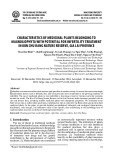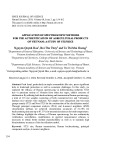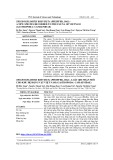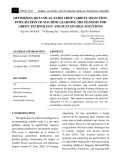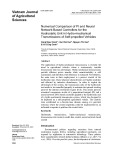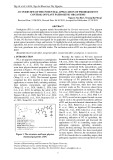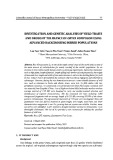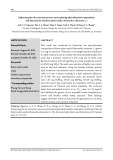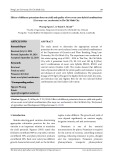
196 Nong Lam University, Ho Chi Minh City
The Journal of Agriculture and Development 23(Special issue 1) www.jad.hcmuaf.edu.vn
Effects of partial precipitation and freeze-drying on morphology and physicochemical
properties of rice starch hydrolysates
Ha V. Do*, Anh T. Vu, & Phuong T. Nguyen
Faculty of Chemical Engineering and Food Technology, Nong Lam University, Ho Chi Minh City,
Vietnam
ARTICLE INFO ABSTRACT
Research Paper
Received: August 27, 2024
Revised: October 02, 2024
Accepted: October 18, 2024
Keywords
Alpha-amylase
Dextrose equivalent
Modified rice starch
Morphology
Physicochemical properties
*Corresponding author
Do Viet Ha
Email:
dovietha@hcmuaf.edu.vn
Agricultural bio-catalysis is of immense scientific interest due to its
increasing importance in the efforts for more sustainable agriculture
while optimizing environmental impacts. In our studies, native rice
starch was hydrolyzed with various alpha-amylase concentrations
(0, 0.1, 0.2, and 0.3% w/w of starch) at 50°C for 20 min; then
purified by partial precipitation (PP) with organic solvents, or
freeze-drying (FD) without further purification. The rice starch
hydrolysates (RSH) produced by different methods (PP or FD)
were determined for dextrose equivalent (DE), morphology, and
some physicochemical properties including bulk density, moisture
content, hygroscopicity, and water solubility. The results showed
that at the same alpha-amylase treatment conditions, the RSH
obtained by the PP method had lower DE values and production
yields than those of RSH obtained by FD method. The FD-RSH
had higher DE values, lower bulk densities and moisture contents,
higher hygroscopicity and water solubility. In morphology, the
PP-RSH (DE 10.2) had a larger particle size and more condensed
microstructure compared to the FD-RSH of almost similar DE 13.5.
These findings showed that the PP method resulted in lower-DE
RSH with different morphological and physicochemical properties
compared to those obtained by the FD method.
Cited as: Do, H. V., Vu, A. T., & Nguyen, P. T. (2024). Effects of partial precipitation and freeze-
drying on morphology and physicochemical properties of rice starch hydrolysates. The Journal of
Agriculture and Development 23(Special issue 1), 196-204.

Nong Lam University, Ho Chi Minh City 197
The Journal of Agriculture and Development 23(Special issue 1) www.jad.hcmuaf.edu.vn
drying) could affect the hydrolysates’ molecular
mass, DE values, degree of polymerization
(DP) range, and physicochemical properties
(Kalac et al., 1984; Balto et al., 2016; Wang et
al., 2020). This paper aims to study the effects
of partial precipitation (PP) and freeze-drying
(FD) methods on DE values, morphological
and physicochemical properties of rice starch
hydrolysates to have a better understanding of
the properties of SHP produced from different
botanical source, different purification and
drying methods.
2. Materials and Methods
2.1. Materials and chemicals
Native normal rice starch (NRS) (Tai Ky
Food Co., Vietnam) was purchased from a
supermarket in Ho Chi Minh City, Vietnam.
Aspergillus oryzae alpha-amylase (AAM) and
commercial dextrin GLUCIDEX-12 were
purchased from HiMedia Laboratories (India)
and Roquette Freres (France). The organic
solvents, acetone 100% and ethanol 96°, and
chemical reagents, glucose (C6H12O6), iodine (I2),
potassium iodine (KI), hydrochloride (HCl 37%),
sodium chloride (NaCl), sodium hydroxide
(NaOH), sodium dihydrogen phosphate
dihydrate (NaH2PO4.2H2O), disodium hydrogen
phosphate dodecahydrate (Na2HPO4.12H2O),
3,5-dinitrosalicylic acid (DNS) (C7H4N2O7),
and sodium potassium tartrate tetrahydrate
(KNaC4H4O6.4H2O) were provided by Xilong
Scientific (China).
2.2. Alpha-amylase hydrolysis of rice starch
The NRS was hydrolyzed with a fungal alpha-
amylase following the method of Do et al. (2023)
with minor modifications. NRS slurries containing
20% of NRS (w/v) in 0.1 M sodium phosphate
1. Introduction
Maltodextrins and glucose syrups are
starch hydrolysis products (SHP) have found
wide applications in the food, cosmetic and
pharmaceutical industries (Castro et al., 2016).
They are commercially produced from native
starch through partial hydrolysis, purification,
and spray-drying (Takeiti et al., 2010). They are
usually classified by their values of Dextrose
Equivalent (DE), a quantity that indicates the
number of dextrose molecules released from the
hydrolysis of starch and expressed as a percentage
of the dextrose on a dry-weight basis (Dokic
et al., 2004; Yunianta et al., 2015). Starch has a
DE value of zero, while glucose has a DE value
of 100. Maltodextrins are low convert starch
products with DE values lower than 20, while
high convert starch products with values equal
and higher than 20 are known as corn syrup
solids and glucose syrups (Klinkesorn et al., 2004;
Saavedra-Leos et al., 2015; Balto et al., 2016).
Their physicochemical and functional properties
are influenced and controlled by the type (acid or
enzymatic) and extend of hydrolysis, amylose to
amylopectin ratio, source of starch, etc. (Dokic
et al., 2004).
Starches from various botanical sources such
as corn, cassava, manioc, wheat, oatmeal, sago,
canna, maize, potato, and rice can be used for
production of SHP (Klinkesorn et al., 2004;
Moore et al., 2005; Takeiti et al., 2010). Traditional
methods of acid hydrolysis resulted in products
which are not completely soluble, colored and
have a starchy taste, while enzymatic methods
have been used to prepare soluble, non-hazy
low DE-value maltodextrins (Dokic et al., 1998).
Besides, the purification process such as partial
precipitation of hydrolysates with polar organic
solvents or drying methods (spray-drying/freeze-

198 Nong Lam University, Ho Chi Minh City
The Journal of Agriculture and Development 23(Special issue 1) www.jad.hcmuaf.edu.vn
2.5. Scanning electron microscopy (SEM)
observation
Morphological characteristics of the starch
samples were observed using a Scanning Electron
Microscope (S-4800, Hitachi, Japan) according
to Do et al. (2023).
2.6. Physicochemical properties
Bulk density was obtained by gravimetric
method according to Takeiti et al. (2010),
weighing a sample powder poured into a 25 mL
graduated cylinder. Bulk density was calculated as
the material weight divided by the bulk volume.
Moisture content of the samples was
determined by gravimetric method using an
oven, measured as the percent moisture loss after
drying to the initial wet weight of the sample
(Duong et al., 2024).
Hygroscopicity was analyzed using 1 g of
sample that was put in an aluminum cup and
dried with the oven over the past 24 h, then dried
sample was conditioned at relative humidity 96%
in a closed saturated K2SO4 solution-containing
chamber and weight was performed daily until
equilibrium reached according the method of
Hartiningsih et al. (2020). Percent moisture
reabsorption of the sample was calculated
concerning its initial dried weight.
Solubility of samples was analyzed according
to Hartiningsih et al. (2020). Weighed 0.5 g of
sample, dissolved into 50 mL of distilled water and
stirred at 4000 rpm for 2 min using a homogenizer
(T25, IKA, Germany). The suspension was
centrifuged at 4000 rpm for 15 min, and 25 mL of
the supernatant was taken and dried in the oven at
105°C for 48 h and obtained dry weight. Solubility
was calculated as percent dry weight dissolved in
the supernatant to the sample weight.
buffer of pH 6.0 were gelatinized at 95°C for 30
min and hydrolyzed with various concentrations
of AAM (0, 0.1, 0.2, and 0.3% w/w of NRS) at
50°C for 20 min. The reactions were terminated
by heating the mixtures at 95°C for 30 min.
2.3. Rice starch hydrolysates (RSH) purification
and drying
After enzyme termination, each hydrolyzed
mixture was cooled to room temperature and
divided into two equal weight portions: the rice
starch hydrolysates (RSH) in the first portion was
purified by PP with organic solvents: hydrolysate
precipitation using 3-fold volume of ethanol
96o following purification using ethanol 96o and
acetone, then oven-drying at 45°C for 24 h; while
the RSH in the remaining portion was obtained
by FD method without purification. Yield of
RSH was calculated as the percent weight of
hydrolyzed starches to the initial weight of rice
starch used for hydrolysis (Gunawan et al., 2023).
2.4. Dextrose Equivalent (DE) determination
DE values of NRS, commercial dextrin,
and RSH were determined according to the
method of Yunianta et al. (2015) with some
modifications. Approximately 35 mg of sample
was dissolved in 5 mL of distilled water, mixed
with 15 mL of DNS solution, made up to 50 mL
with distilled water, boiled for 45 min, cooled
to room temperature, and then measured for
absorbance at a wavelength of 540 nm. The
dextrose or reducing sugar content in the sample
was compared with glucose standard and the DE
value of the sample was calculated according to
the following formula, where C is reducing sugar
content (mg/mL), V is volume of sample solution
(mL), and m is sample weight (mg).
chemical reagents, glucose (C6H12O6), iodine (I2), potassium iodine (KI), hydrochloride 1
(HCl 37%), sodium chloride (NaCl), sodium hydroxide (NaOH), sodium dihydrogen 2
phosphate dihydrate (NaH2PO4.2H2O), disodium hydrogen phosphate dodecahydrate 3
(Na2HPO4.12H2O), 3,5-dinitrosalicylic acid (DNS) (C7H4N2O7), and sodium potassium 4
tartrate tetrahydrate (KNaC4H4O6.4H2O) were provided by Xilong Scientific (China). 5
2.2. Alpha-amylase hydrolysis of rice starch 6
The NRS was hydrolyzed with a fungal alpha-amylase following the method of Do et 7
al. (2023) with minor modifications. NRS slurries containing 20% of NRS (w/v) in 0.1 M 8
sodium phosphate buffer of pH 6.0 were gelatinized at 95 C for 30 min and hydrolyzed 9
with various concentrations of AAM (0, 0.1, 0.2, and 0.3% w/w of NRS) at 50 C for 20 10
min. The reactions were terminated by heating the mixtures at 95 C for 30 min. 11
2.3. Rice starch hydrolysates (RSH) purification and drying 12
After enzyme termination, each hydrolyzed mixture was cooled to room temperature 13
and divided into two equal weight portions: the rice starch hydrolysates (RSH) in the first 14
portion was purified by PP with organic solvents: hydrolysate precipitation using 3-fold 15
volume of ethanol 96% v/v following purification using ethanol 96% v/v and acetone, then 16
oven-drying at 45 C for 24 h; while the RSH in the remaining portion was obtained by FD 17
method without purification. Yield of RSH was calculated as the percent weight of 18
hydrolyzed starches to the initial weight of rice starch used for hydrolysis (Gunawan et al., 19
2023). 20
2.4. Dextrose Equivalent (DE) determination 21
DE values of NRS, commercial dextrin, and RSH were determined according to the 22
method of Yunianta et al. (2015) with some modifications. Approximately 35 mg of 23
sample was dissolved in 5 mL of distilled water, mixed with 15 mL of DNS solution, made 24
up to 50 mL with distilled water, boiled for 45 min, cooled to room temperature, and then 25
measured for absorbance at a wavelength of 540 nm. The dextrose or reducing sugar 26
content in the sample was compared with glucose standard and the DE value of the sample 27
was calculated according to the following formula, where C is reducing sugar content 28
(mg/mL), V is volume of sample solution (mL), and m is sample weight (mg). 29
30
DE =
!
´
#
$
´ 100%
31
32
2.5. Scanning electron microscopy (SEM) observation 33

Nong Lam University, Ho Chi Minh City 199
The Journal of Agriculture and Development 23(Special issue 1) www.jad.hcmuaf.edu.vn
by the FD method had higher yields of lower DP
and lower molecular mass molecules. Fractional
precipitation of aqueous solutions of partly
hydrolyzed starches using organic solvents was
performed to obtain different molecular mass
fractions (Kalac et al., 1984). Ethanol was used
for precipitation of starch and SHP in aqueous
solutions and high ratio of ethanol (70% ethanol)
narrowed ranges of maltooligosaccharides and
preferentially removed glucose and maltose from
SHP (Balto et al., 2016; Gunawan et al., 2023).
Therefore, the PP method used in this study
could narrow ranges of SHP to higher DP range
and remove glucose and maltose which resulted
in lower yields of RSH. The FD method without
purification resulted in RSH with higher DE
values and higher yields. Based on DE values,
RSH could be classified into maltodextrins (DE
2-20) including PP-2001 (DE 3.9), PP-2002 (DE
7.2), PP-2003 (DE 10.2), and FD-2001 (DE 13.4),
and glucose syrups were FD-2002 (DE 20.7) and
FD-2003 (DE 37.6).
2.7. Statistical analysis
All measurements were performed in
triplicate and results were expressed as means
± standard deviation. The analysis of variance
(ANOVA) and the least significant difference
(LSD) were performed at a value of P < 0.05.
3. Results and Discussion
3.1. Effects of hydrolysis degree, recovery and
purification method on DE values
Table 1 showed measured DE values and
yields of RSH obtained by PP and FD method.
All the results were statistically significant
differences. The PP method produced RSH with
lower DE values (1.3 - 10.2) and yields (31.2 -
66.2%) compared to those (1.1 - 37.6 and 82.5 -
89.2%) obtained by the FD method. These results
showed that the RSH produced by PP method
were more purified with higher DP and higher
molecular mass molecules, while those obtained
Table 1. Measured dextrose equivalent (DE) values of different types of rice starch hydrolysates (RSH)
Sample CAAM (%) Yield (%) DE
PP-control10 66.2 ± 1.4d1.30 ± 0.06b
FD-control20 88.8 ± 1.3g1.09 ± 0.02a
PP-200130.1 51.2 ± 3.3c3.88 ± 0.04c
FD-200140.1 86.5 ± 1.1f13.45 ± 0.06f
PP-200250.2 31.2 ± 3.9a7.15 ± 0.01d
FD-200260.2 82.5 ± 0.4e20.72 ± 0.10g
PP-200370.3 39.7 ± 5.1b10.22 ± 0.02e
FD-200380.3 89.2 ± 2.1h37.64 ± 0.06h
The data within a column followed by the different superscript letter are statistically significant difference (P <
0.05). CAAM: alpha-amylase concentration; DE: dextrose equivalent; PP: partial precipitation; FD: freeze-drying.
1RSH (rice starch hydrolysates) obtained by PP of AAM-untreated rice starch.
2RSH obtained by FD of AAM-untreated rice starch.
3RSH obtained by PP of 0.1% AAM-treated rice starch.
4RSH obtained by FD of 0.1% AAM-treated rice starch.
5RSH obtained by PP of 0.2% AAM-treated rice starch.
6RSH obtained by FD of 0.2% AAM-treated rice starch.
7RSH obtained by PP of 0.3% AAM-treated rice starch.
8RSH obtained by FD of 0.3% AAM-treated rice starch.

200 Nong Lam University, Ho Chi Minh City
The Journal of Agriculture and Development 23(Special issue 1) www.jad.hcmuaf.edu.vn
less than 10 mm (Figure 1A), the PP-2003 has
non-granular condense body shape with par-
ticle size larger than 50 mm (Figure 1B), while
the FD-2001 (Figure 1C) and the commercial
maltodextrin GLUCIDEX-12 (Figure 1D) have
fragment structures with various sizes. The mor-
phological differences found could be attributed
to the PP and FD method of RSH which led to
their different physicochemical properties men-
tioned below.
3.2. Morphological characteristics
The NRS, PP-2003 (DE 10.2), FD-2001 (DE
13.5), and commercial maltodextrin GLUCI-
DEX-12 (DE 12) powders were chosen for SEM
observations in Figure 1 to see the influence of
alpha-amylase treatments, purification and dry-
ing method on the morphologies of RSH when
compare to those of NRS and commercial malto-
dextrin. SEM micrographs showed that granules
of the NRS had irregular cubic shapes with size
Figure 1. SEM micrographs of NRS (A), PP-2003 (B), FD-2001 (C), and GLUCIDEX-12 (D). NRS:
normal rice starch; PP: partial precipitation; FD: freeze-drying.
A
B
C
D

